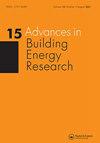A new regression model to predict BIPV cell temperature for various climates using a high-resolution CFD microclimate model
IF 2.5
Q2 CONSTRUCTION & BUILDING TECHNOLOGY
引用次数: 5
Abstract
ABSTRACT Understanding of cell temperature of Building Integrated Photovoltaics (BIPV) is essential in the calculation of their conversion efficiency, durability and installation costs. Current PV cell temperature models mainly fail to provide accurate predictions in complex arrangement of BIPVs under various climatic conditions. To address this limitation, this paper proposes a new regression model for prediction of the BIPV cell temperature in various climates and design conditions, including the effects of relative PV position to the roof edge, solar radiation intensity, wind speed, and wind direction. To represent the large number of possible climatic and design scenarios, the advanced technique of Latin Hypercube Sampling was firstly utilized to reduce the number of investigated scenarios from 13,338 to 374. Then, a high-resolution validated full-scale 3-dimensional Computational Fluid Dynamics (CFD) microclimate model was developed for modelling of BIPV’s cell temperature, and then was applied to model all the reduced scenarios. A nonlinear multivariable regression model was afterward fit to this population of 374 sets of CFD simulations. Eventually, the developed regression model was evaluated with new sets of unused climatic and design data when a high agreement with a mean discrepancy of 3% between the predicted and simulated BIPV cell temperatures was observed.使用高分辨率CFD小气候模型预测不同气候下BIPV电池温度的新回归模型
摘要了解建筑集成光伏(BIPV)的电池温度对于计算其转换效率、耐用性和安装成本至关重要。目前的光伏电池温度模型在各种气候条件下,在复杂的BIPV布置中主要无法提供准确的预测。为了解决这一局限性,本文提出了一种新的回归模型,用于预测不同气候和设计条件下的BIPV电池温度,包括光伏相对位置对屋顶边缘、太阳辐射强度、风速和风向的影响。为了表示大量可能的气候和设计场景,首先利用拉丁超立方体采样的先进技术将调查场景的数量从13338个减少到374个。然后,开发了一个经过高分辨率验证的全尺寸三维计算流体动力学(CFD)小气候模型,用于BIPV电池温度的建模,然后应用于所有简化场景的建模。随后,将非线性多变量回归模型拟合到374组CFD模拟的群体中。最终,当观察到预测和模拟的BIPV电池温度之间的平均差异为3%时,用新的未使用的气候和设计数据集对开发的回归模型进行了评估。
本文章由计算机程序翻译,如有差异,请以英文原文为准。
求助全文
约1分钟内获得全文
求助全文
来源期刊

Advances in Building Energy Research
CONSTRUCTION & BUILDING TECHNOLOGY-
CiteScore
4.80
自引率
5.00%
发文量
11
 求助内容:
求助内容: 应助结果提醒方式:
应助结果提醒方式:


